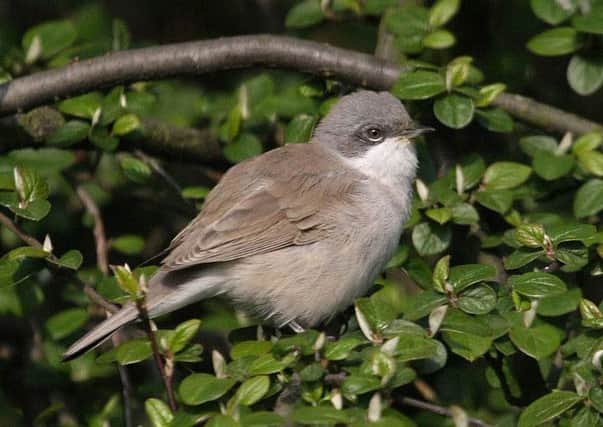Birdwatch: Masked males burst into song to break their secretive cover


I had an excellent view of a newly arrived bird last week with its smart grey upper parts contrasting with white under parts and dark cheek feathers standing apart from its white throat, giving a ‘masked’ look.
It was singing frequently but this period is unusually short for a warbler, a maximum of a fortnight, after which its highly secretive nature establishes resumes.
Advertisement
Hide AdAdvertisement
Hide AdLesser whitethroats are notorious skulkers, spending much of their time deep within thick vegetation and do not have the high-flying, easily observed song flight of the common whitethroat.
Although similar in appearance to the common whitethroats, DNA testing has found that the lesser is in fact closely related to the Hume’s and desert whitethroats, both of which breed eastwards from Iran.
The strongholds for the lesser whitethroat are in central and eastern Europe but they have steadily expanded northwards as far as Scotland where there are some 400 pairs. A handful of pairs now breed in Ireland too, mainly in the east of the country.
They have quite a different migration route compared with most other spring arrivals. After wintering in Egypt, Sudan, Chad and Ethiopia, they move through Israel, the Lebanon and Syria, and then across Turkey, southern Europe, Germany and the Low Countries before making the sea crossing to the UK.
Advertisement
Hide AdAdvertisement
Hide AdIn August and September, juvenile and first winter birds can be easier to see as they feed in willows and shrubs, sometimes joining roaming tit flocks.
When they leave us they cross France and into northern Italy where they pause to build up reserves before continuing eastwards.
Cold northerly winds have blocked large-scale arrivals of migrants but the first whinchats of the year started to be seen. There were also more willow, sedge, reed and grasshopper warblers. Hobbies were reported chasing sand martins and swallows over the Mere at the Old Moor reserve and Wintersett reservoir, South Yorkshire.
Dotterels were seen on their way back from Africa’s Atlas Mountains to breeding sites in Scotland with two present for a day in a field near Old Fall Hedge at Flamborough, a male at Peat Pits, Edge Mount, Sheffield and a male and female near the summit of Pendle Hill.
Advertisement
Hide AdAdvertisement
Hide AdThe first greenshanks and more whimbrels were seen on their way north. Up to 40 whimbrels are now roosting on the Wheldrake Ings reserve near York.
A pectoral sandpiper was reported at the North Cave wetland in East Yorkshire.
Some winter visitors are still with us with a great grey shrike seen and photographed last week on Newby Moor near Clapham, North Yorkshire and another this week along the road from Bempton village to the RSPB reserve.